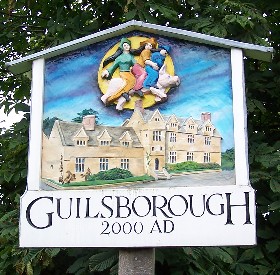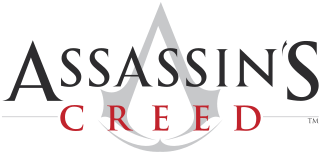
Daventry District was a local government district in western Northamptonshire, England, from 1974 to 2021. The district was named after its main town of Daventry, where the council was based.

Stourton Caundle is a village and civil parish in the county of Dorset in southwest England. It lies within the Blackmore Vale, about five miles east of Sherborne. In the 2011 census the parish had 181 households and a population of 439.

Guilsborough is a village and civil parish in West Northamptonshire in England. At the time of the 2001 census, the parish's population was 882 people, reducing to 692 at the 2011 Census.

Stanford-on-Avon is a village in the civil parish of Stanford in West Northamptonshire, England. It lies next to the River Avon, which here forms the county boundary between Northamptonshire and Leicestershire. On the Leicestershire side of the river is Stanford Hall, a historic house. Stanford Reservoir is one mile north of the village. The population is included in the civil parish of Clay Coton.

Mears Ashby is a village in the county of Northamptonshire, England. It lies between the county town of Northampton and Wellingborough and was in the West ward of borough council of Wellingborough area which also included Sywell prior to local government reform in 2021. At the time of the 2011 census, it had a population of 473.

Ashton is a village and civil parish about ¾ mile east of Oundle in the east of the English county of Northamptonshire forming part of the unitary authority of North Northamptonshire. The population of the civil parish at the 2011 census was 219.

Quatford is a village in the civil parish of Bridgnorth, in the Severn Valley, Shropshire, England. It is located on the A442, just south of the town of Bridgnorth and on the bank of the River Severn. The majority of residents in the village live on one of the Caravan Parks.

Mitchell's Fold is a Bronze Age stone circle in southwest Shropshire, located near the small village of White Grit on dry heathland at the southwest end of Stapeley Hill in the civil parish of Chirbury with Brompton, at a height of 1083 ft (330m) o.d.

Coton is a hamlet and former civil parish, now in the parish of Ravensthorpe, in the West Northamptonshire district, in the ceremonial county of Northamptonshire, England. It is located between Guilsborough and Ravensthorpe. Coton Manor is a popular visitor attraction for its gardens and bluebell woods. In 1931 the parish had a population of 83.

Ubisoft Anvil is a game engine created by Ubisoft Montreal and used in the Assassin's Creed video game series as well as other Ubisoft games. The engine is used on Microsoft Windows, macOS, Nintendo Switch, PlayStation 3, PlayStation 4, PlayStation 5, PlayStation Vita, Wii U, Xbox 360, Xbox One, Xbox Series X/S and Stadia. Ubisoft Anvil is one of the primary game engines used by Ubisoft along with Disrupt, Dunia, and Snowdrop.

Abington Park, in the Abington district of Northampton, Northamptonshire, England, has lakes, aviaries, and a museum, as well as trees and grassy open spaces.

West Northamptonshire is a unitary authority area in the ceremonial county of Northamptonshire, England, and was created in 2021. It contains the county town of Northampton, as well as Daventry, Brackley and Towcester; the rest of the area is predominantly agricultural villages though it has many lakes and small woodlands.

Pendleton is a small village and civil parish in Ribble Valley, within the county of Lancashire, England. It is close to the towns of Whalley and Clitheroe. The parish lies on the north west side of Pendle Hill below the Nick o' Pendle. The village is just off the A59, Liverpool to York main road, since the construction of the Clitheroe By-Pass. Older roads through the parish include one from Clitheroe to Whalley which passes through the Standen area and another to Burnley which passes Pendleton Hall.

The Northamptonshire witch trials mainly refer to five executions carried out on 22 July 1612 at Abington Gallows, Northampton. In 1612 at the Lent Assizes held in Northampton Castle a number of women and a man were tried for witchcraft of various kinds, from murder to bewitching of pigs. There are two main accounts of these witches being tried. However they differ on how many witches were tried, who they were and exactly what they were supposed to have done.

The trials of the Pendle witches in 1612 are among the most famous witch trials in English history, and some of the best recorded of the 17th century. The twelve accused lived in the area surrounding Pendle Hill in Lancashire, and were charged with the murders of ten people by the use of witchcraft. All but two were tried at Lancaster Assizes on 18–19 August 1612, along with the Samlesbury witches and others, in a series of trials that have become known as the Lancashire witch trials. One was tried at York Assizes on 27 July 1612, and another died in prison. Of the eleven who went to trial – nine women and two men – ten were found guilty and executed by hanging; one was found not guilty.

Assassin's Creed is a historical action-adventure video game series and media franchise published by Ubisoft and developed mainly by its studio Ubisoft Montreal using the game engine Anvil and its more advanced derivatives. Created by Patrice Désilets, Jade Raymond, and Corey May, the Assassin's Creed video game series depicts a fictional millennia-old struggle between the Order of Assassins, who fight for peace and free will, and the Knights Templar, who desire peace through order and control. The series features historical fiction, science fiction, and fictional characters intertwined with real-world historical events and historical figures. In most games, players control a historical Assassin while also playing as an Assassin Initiate or someone caught in the Assassin–Templar conflict in the present-day framing story. Considered a spiritual successor to the Prince of Persia series, Assassin's Creed took inspiration from the novel Alamut by the Slovenian writer Vladimir Bartol, based on the historical Hashashin sect of the medieval Iran (Persia).
The Assassin's Creed series is a collection of novels by various authors, set within the fictional universe of the Assassin's Creed video game franchise created by Ubisoft. The books are set across various time periods and, like the games, revolve around the secret war fought for centuries between the Assassin Brotherhood and the Templar Order. The series includes both direct novelizations of several Assassin's Creed games, and books that function as standalone narratives, although some of these tie-in with one or more of the games in the franchise. British publishing house Penguin Books was responsible for the publication of most of the novels in the series, as well as their respective audiobook versions, until 2020, when Aconyte Books took over as the main publisher of the series.

Assassin's Creed Odyssey is a 2018 action role-playing game developed by Ubisoft Quebec and published by Ubisoft. It is the eleventh major installment in the Assassin's Creed series and the successor to 2017's Assassin's Creed Origins. Like its predecessor, the game features a large open world and adopts many elements from the role-playing genre, putting more emphasis on combat and exploration than stealth. Naval combat from previous titles in the series also plays a prominent role in Odyssey. The game's plot tells a mythological history of the Peloponnesian War between Athens and Sparta from 431 to 422 BC. Players control a Spartan mercenary, who fights on both sides of the conflict as they attempt to find their family and eliminate the mysterious Cult of Kosmos. Odyssey also continues the story arc of Layla Hassan, a major character introduced in Origins, who relives the mercenary's memories through the Animus device to find a powerful artifact.

Assassin's Creed Valhalla is a 2020 action role-playing game developed by Ubisoft Montreal and published by Ubisoft. It is the twelfth major installment in the Assassin's Creed series, and the successor to 2018's Assassin's Creed Odyssey. Principally set in the years 872–878 AD, the game recounts a Viking fantasy story during their expansions into the British Isles. Players control Eivor Varinsdottir, a Viking raider who, while attempting to establish a new Viking clan in England, becomes embroiled in the centuries-old conflict between the Assassin Brotherhood, who fight for peace and liberty, and the Templar Order, who desire peace through control. The game also includes a framing story, set in the 21st century, which follows Layla Hassan, an Assassin who relives Eivor's memories so as to find a way to save the Earth from destruction.

Assassin's Creed Mirage is a 2023 action-adventure game developed by Ubisoft Bordeaux and published by Ubisoft. The game is the thirteenth major installment in the Assassin's Creed series and the successor to 2020's Assassin's Creed Valhalla. While its historical timeframe precedes that of Valhalla, its modern-day framing story succeeds Valhalla's own. Set in 9th-century Baghdad during the Islamic Golden Age—in particular during the Anarchy at Samarra—the story follows Basim Ibn Ishaq, a street thief who joins the Hidden Ones to fight for peace and liberty, against the Order of the Ancients, who desire peace through control. The main narrative focuses on Basim's internal struggle between his duties as a Hidden One and his desire to uncover his mysterious past.





















